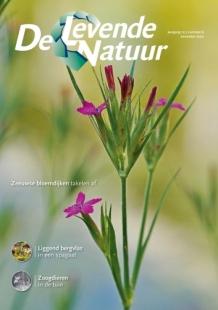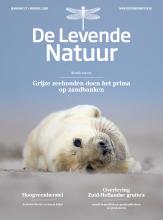De Levende Natuur nummer 6 van 2020 (English summary)
Afbeelding

Can the floristic decline of the Zeeland flower dikes be stopped?
Willem-Jan Emsens, Roland Bobbink, Peter Maas & Fransje Mooij
The Dutch province of Zeeland is characterized by a large network of manmade calcareous dikes that harbor many endangered plant species. The traditional management of sheep and cattle herding on the dikes was abandoned over time, while agricultural practices in the surrounding landscape gradually intensified. Since the last few decades, vegetation diversity has been decreasing rapidly. By investigating edaphic properties and vegetation composition, we found that eutrophication with nitrogen and phosphorus is one of the primary drivers behind this loss of biodiversity. We propose future management to focus on restoration by soil nutrient depletion, e.g. by an intensified mowing regime or shallow sod cutting. These measures should be combined with manual transfer of seeds of key plant species to overcome dispersal limitation, as well as with the establishment of 15 m wide fertilizerfree buffer zones surrounding the dikes. After restoration, the reintroduction of less intensive or traditional management practices should be reconsidered.
Insect monitoring: comparing three widely used methods
Dennis Lammertsma, Jeltje Stam, Dennis te Beest, Wim Ozinga, Anne Schmidt & David Kleijn
The decline of insects recently received much attention in the Netherlands. However, surprisingly little is known about even the basic composition of insect communities. To learn more about insects in different habitats, and the best ways to monitor them, a 1992 insectdataset was reanalysed. Data was collected with three simultaneous applied trapping methods in thirteen different habitat types during four seasons in lowland marshes. The three trapping methods that were used (malaise traps, pyramid traps and pitfall traps) differed in the number and arthropod species trapped, which has implications for conclusions that could be drawn from them. Analysis showed that the sequence of habitat types (high to low number of catches) changed depending on trap type used. It is concluded that it would be worthwhile to perform a simultaneous study of all available methods in order to make science based decisions on the application of these different methods for answering different research questions.
Mammals in Deventer gardens
Sil Westra, Natasja Menses & Roy Mol
Urban area has become one of the important land uses in the Netherlands. Studies have shown that gardens may play a role in becoming a new (partial) habitat for some wildlife species, but much is still unknown. In 2016 Silvavir ecological consultants teamed up with the Dutch Mammal Society, University of Wageningen and the Belgian nature conservation organization Natuurpunt to start a citizen science project in which volunteers collected data on wild mammals in gardens by using camera traps. Between May 2016 and November 2017, a total of 84 locations in gardens were examined with a camera trap using a fixed protocol. Gardens had different characteristics and locations spread across the Dutch municipality of Deventer. The camera traps captured wild mammal species that regularly use gardens. A total of 42 animal species and 17 mammals were identified. Most mammal species occurred in rural and suburban areas. This seems to confirm the hypothesis that suburban areas are important for wild mammals. However, the total number of sampled locations is limited. House cats are by far the most abundant and widespread mammal species identified. The most abundant wild species were house mouse, wood mouse and hedgehog. The most widespread wild species were hedgehog, stone marten and wood mouse.
Bastard-toadflax needs customised management
Anton van Haperen, Gerard Oostermeijer, Bas Arens, Annemieke Kooijman & Mark van Til
Bastard-toadflax has only one rather small population in The Netherlands, in the dunes south of Katwijk (Natura 2000-site Meijendel & Berkheide). Here the species reaches the northern limits of its Atlantic distribution area. The nearest neighbour populations are situated in the Flemish dunes close to the French border (170 km SW). The two populations are genetically almost totally separated. At present near Katwijk Bastard-toadflax only occurs around blowouts, where small quantities of calcareous shifting sands prevent acidification of the topsoil. Probably because of the higher calcium content of the soil (fig. 3) the species has a broader ecological amplitude in the Flemish dunes. Here it also occurs in older grasslands with a more organic and sometimes also a more humid neutral soil. Near Katwijk, conservation of the population depends on a fragile balance between acidification of the topsoil and encroachment of the vegetation, in particular invasive non-native species, on one hand and the danger of being covered by large quantities of shifting sand on the other. Conservation management should therefore aim at regulation of blowouts and shifting sand by placing drift screens when and where needed and the reduction of vegetation encroachment by grazing. Though the Katwijk population is small and shows clear signs of inbreeding, there are no indications for a need of ‘genetic rescue’ measures. Given the high genetic differentiation with the Belgian populations, such measures bear a strong risk of outbreeding depression, which could lower rather than increase population viability.
National trends in insect flower abundance
Michiel Wallis de Vries
The decline of flower-visiting insects can be expected to be driven to a significant extent by declines in flower abundance. However, data on flower abundance are lacking. This paper presents the results of systematic flower counts over the period 1992-2018 by citizen scientists participating in the Dutch Butterfly Monitoring Scheme. The results on fourteen flower groups indicate a recovery of total flower abundance to initial levels after a period lower abundance between 2007 and 2015. However, the trend of the most important flower group for butterflies – thistles – shows a 47 % decline in 2016-2018 compared to 1994- 1995. We recommend that efforts to conduct systematic flower counts should be increased to gain insight into the habitat and management factors that govern their abundance.

